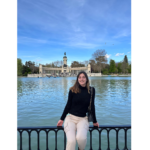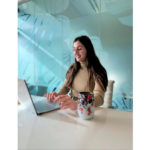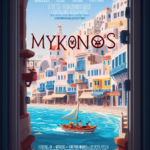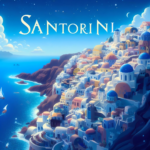
Elli Iliadou is an accomplished artist whose evocative pictures capture the essence of places and situations, drawing profound inspiration from the beauty of Greece. Her work, celebrated for its vivid portrayal of Greek landscapes and cultural moments, has garnered admiration and sparked a deep appreciation for Greece’s natural and historical splendor. Through her project, Fantasia Greece, Elli has enchanted audiences worldwide, cultivating a love and reverence for Greek aesthetics. Her artistic vision not only highlights the breathtaking scenery but also tells compelling stories that resonate with those who cherish her unique perspective on Greek beauty.
Can you tell us about your academic background in pedagogy and public history and how it has influenced your career path in marketing at Teleperformance?
When I was 18, I decided to study pedagogy because I thought that I always liked the idea of teaching. As I got deeper into my studies, I realized that the Greek educational system wasn’t the best fit for me. It felt pretty restrictive and didn’t leave much room for creativity, which was a big deal for me. It wasn’t just a Greek thing, though—I also volunteered in schools in Poland, Romania, and Portugal, and I noticed similar issues there too. These experiences pushed me away from a traditional teaching career.
After finishing my degree, I was a bit unsure about what to do next. So, I decided to try something new and went for a master’s degree in public history. I’m actually finishing my thesis now. During this period, I was also experimenting and trying new things. I got involved in various voluntary projects, learned a lot, and eventually stumbled upon digital marketing.
I started my first job in digital marketing for Meta as a consultant through the outsourcing company Teleperformance and one year later for Google through the same outsourcing company and I absolutely loved it. It was creative, dynamic, and exactly what I was looking for. It might have taken me a few years to find my true passion, but every step of the journey was worth it. My experiences in education gave me a unique perspective, and that has been really valuable in my marketing career at Teleperformance, especially when advising clients.
Looking back, even though my path wasn’t straightforward, I wouldn’t change a thing. Every twist and turn helped me discover what I really enjoy doing.
How did your Erasmus experience in Lisbon contribute to your personal and professional growth, and how do you apply those learnings in your current role?
Erasmus is such an amazing opportunity for us Europeans. It allows you to travel, experience new cultures, and make international friends. But for me, the most important part was learning how to step out of my comfort zone. Moving to Lisbon for the first time was a huge step—it was my first time living abroad for an extended period. It was stressful and challenging to leave my family and friends behind and navigate life on my own.
At first, even walking into university classes full of Portuguese students seemed pretty intimidating. I had to find an apartment, learn my way around a new city, and pick up some of the language. Some days were truly stressful but I’m grateful because these experiences taught me to be independent and self-reliant. It wasn’t always easy, but every new start is tough unless you give it a try.
If it weren’t for pushing myself out of my comfort zone during Erasmus, I might never have tried a job in such a different field or moved abroad to work. Those experiences gave me the confidence to take risks and adapt to new environments, which has been incredibly valuable in my current role.
Fantasia.Greece seems like a fascinating initiative. Can you share how you got involved with it and what your role entails?
My involvement with Fantasia.Greece began from a blend of my professional background and personal interests. When I was living in Lisbon, working for Meta, I was advising clients on Facebook and Instagram campaign strategies. My role involved guiding them on their campaign settings, target audience strategy, and the importance of creative content in advertising.
During this time, I developed a keen interest in creating compelling images for their advertising campaigns. I took it upon myself to learn more about image creation and started providing attractive visuals for their product advertisements, which proved to be quite effective.
This sparked a deeper interest in AI-generated imagery. I furthered my skills in this area and began posting my AI-generated images on TikTok. I noticed that these posts were well-received by the audience, which motivated me to continue. This led to the creation of Fantasia.Greece, where I combine my love for Greek beauty with AI art. And recently I started an Instagram account to reach a new audience.
In Fantasia.Greece, my role encompasses everything from conceptualizing and creating AI-generated images to managing the social media strategy and engaging with our audience. It’s incredibly fulfilling to blend AI art and Greece in a way that resonates with people.
Your TikTok posts featuring prints have garnered quite a bit of attention. How do you approach creating content for this platform, and what strategies do you use to engage your audience effectively?
My approach to creating content for TikTok begins with creativity and imagination. I start by thinking about what I would love to see reimagined in a Greek style. This involves brainstorming ideas and envisioning how they could be transformed. Once I have a concept, I assess its feasibility and how it can be brought to life using AI tools.
Each post is crafted to showcase visually stunning AI-generated images that put a playful and imaginative twist on cities, familiar scenes or products. For instance, I might create an image of a Greek city in a Disney Pixar style, an image of the Parthenon made out of marshmallows or reimagine a well-known product in a Greek-inspired style.
To engage my audience, I focus on building a community by asking questions and including interactive elements while I also make sure to reply to comments and messages, which helps foster a sense of connection. Many times, people share their ideas for future posts, and I have to admit, some of their suggestions are incredibly creative and unique. It’s always nice to have so many people brainstorming alongside me.
Keeping people engaged means giving them what they ask for but also being consistent with posting. I try not to make them wait too long to see their ideas come to life in my posts. This keeps them looking forward to the next post and maybe even hitting that follow button in the meantime so that they will see the post on time.
Other major factors that boost engagement are using trending music and staying up-to-date with social media trends. Posting at times when most of my audience is active can also help, though that’s a bit tricky since my followers are Greeks from around the world, spanning multiple time zones.
With the public showing increased interest in prints, how do you customize your marketing approach to cater to different segments of this audience?
Initially, I hadn’t considered selling my prints, but after receiving numerous messages from followers wanting to purchase them, I decided to open an online shop on the Etsy marketplace, which allows me to sell these digital prints. As I continued posting on TikTok, I also received requests for custom work, such as turning a photo of a mother and daughter into a Disney movie poster style. So, I primarily received messages from followers either wanting to buy the prints I had created or requesting custom work.
Subsequently, a well-known Greek page called Greek City Times started sharing my work, for which I am very grateful, as many people from their audience began to take an interest in my designs.
Recently, I decided to open an Instagram account because I noticed it’s a great platform to showcase creations to a wider audience and build a more solid community compared to TikTok.
Your work involves AI design. Could you explain how AI is integrated into the design process, particularly concerning the landscapes of the AI print?
I have to admit, that creating landscapes as AI prints was challenging at first. Some people think you can just ask an AI tool to create a city in a particular style and get a realistic result, but that’s not true for Greek cities, especially. If you try to create London or New York, for example, you can get a certain level of similarity in the AI design, but for Greek cities, that’s not the case yet. I’m sure in the future AI technology will improve to create smaller cities accurately too.
What I do at the moment, and what I’ve found to be the most accurate way to create landscapes, involves a lot of studying and attention to detail. I spend time researching a city: its architecture, vegetation, general layout, and any special characteristics it might have. If there’s a strong feature in a city, I highlight it to make it stand out in the AI design.
For example, one of the first cities I worked in was Kastoria, my hometown. Because I know it so well and could describe these details accurately, the AI designs always turned out superior compared to other cities that needed more time and effort.
After analyzing the city, prompt construction is critical. It’s about translating the visual elements of my idea into text that the AI can understand and execute.
In general, it can be a time-consuming process, and the results can take a while, but I find it very creative and interesting. I really enjoy the process.
In your experience, how accurate is AI in creating these prints, and what measures do you take to ensure the highest level of accuracy?
Over the past two years, I’ve seen some amazing improvements in results, and they just keep getting better. Getting high accuracy involves a mix of advanced tech and careful human oversight. It all starts with picking the right AI tool for the job since each one has its strengths. For example, Midjourney is great for creating visually rich and detailed images.
The next crucial step is crafting the perfect prompt. This means clearly describing the scene, including specific elements, colors, and composition details to guide the AI accurately. Using the right keywords and tweaking things based on the initial outputs helps refine the results. Negative prompts are super useful too; they tell the AI what to avoid in the images, helping to remove unwanted elements and get a cleaner result.
The order of words in the prompt matters because it affects how the AI prioritizes elements. Choosing the right style for the image—whether it’s realistic, cartoon, or abstract—is also crucial. Techniques like adding weight to certain keywords and specifying the aspect ratio can further refine the output.
Once the AI generates the images, I go into the post-production phase. This is where I tweak the images to make them look their best. I retouch them to improve rendering and sharpness, adjust the colors to match the desired vibe, and add any extra elements or titles needed to finish the piece. Making sure the final image is both accurate and visually appealing is super important, so I carefully check for any inconsistencies and make the necessary adjustments. This way, I blend the advanced capabilities of AI with some detailed human touch.
How do you see the role of AI evolving in all fields in life in the coming years, and what opportunities or challenges do you anticipate?
AI is set to transform a lot of fields in the coming years. Its potential to revolutionize industries and improve daily life is huge, with plenty of opportunities and challenges to consider. It can handle repetitive tasks, boosting productivity and freeing up humans to focus on more creative and complex projects. For instance, in manufacturing, AI-driven robots take care of assembly lines, while humans concentrate on innovation.
We also need to address ethical concerns, especially with job displacement often being a worry. However, I don’t think it should be as I believe that AI enhances roles rather than replacing them. For example, doctors might use AI for more accurate diagnoses, and journalists might use AI for data analysis, allowing them to focus on investigative work. Also, from talking to several graphic designers and artists, I’ve found that AI supports their work rather than threatening it. They’re not scared of AI-generated images; instead, they find that AI tools can boost their creativity and productivity.
The future of AI is bright for sure, and it’s mostly in our hands to use it ethically to ensure the most positive impact for everyone.

What skills or qualities do you believe are essential for someone working in a marketing position that involves AI design and customization?
I believe that AI can be a powerful tool for anyone in marketing, especially if they take the time to learn how to use it effectively and acquire some technical skills.
Understanding how AI tools work and knowing how to construct effective prompts, including the use of negative prompts, is the most important step but while technical skills enable you to achieve the desired outcomes, creativity and innovation are equally important for envisioning new AI applications in marketing creatives to enhance brand messaging.
Using AI-generated designs in ads also requires strong analytical skills to interpret data and measure their effectiveness and attention to detail to ensure high-quality outputs that align with the brand’s identity. Additionally, ethical awareness is vital for responsible AI use, addressing issues related to privacy, bias, and transparency.
Can you share a specific project or campaign you’ve worked on that you’re particularly proud of, and what lessons did you learn from it?
One project I’m really proud of is a voluntary service I did in Romania. I joined a group of volunteers from all over the world, and together we taught English and shared our cultures with kids in various schools. For a whole summer, we traveled across Romania, mostly visiting rural areas and small villages. Sometimes local families would host us, or local authorities would provide rooms for us.
This experience was incredibly enriching. One of the biggest lessons I learned was the importance of adaptability. Every village and school had its own unique vibe and challenges, so we had to be flexible with our teaching methods and communication styles.
Working with such a diverse group of volunteers and students also helped me develop strong teamwork and leadership skills, which have been super useful in my career since. What made this experience even more special was the sense of community. The support from local families and authorities, and the joy it brought to the kids, was amazing. It reminded me that everyone has something valuable to share and learn from each other.

